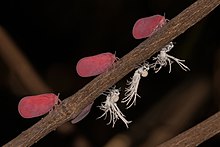Planthopper
| Planthopper Temporal range:
| |
|---|---|

| |
| Flatida rosea (Flatidae) adults and nymphs | |
| Scientific classification | |
| Domain: | Eukaryota |
| Kingdom: | Animalia |
| Phylum: | Arthropoda |
| Class: | Insecta |
| Order: | Hemiptera |
| Suborder: | Auchenorrhyncha |
| Infraorder: | Fulgoromorpha Evans, 1946 |
| Families | |
A planthopper is any
Overview
Planthoppers are laterally flattened and hold their broad wings vertically, in a tent-like fashion, concealing the sides of the body and part of the legs.[3] Nymphs of many fulgoroids produce wax from special glands on the abdominal terga and other parts of the body. These are hydrophobic and help conceal the insects. Adult females of many families also produce wax which may be used to protect eggs.[4]

Fulgoroid nymphs also possess a biological gear mechanism at the base of the hind legs, which keeps the legs in synchrony when the insects jump. The gears, not present in the adults, were known for decades[5] before the recent description of their function.[6]
Planthoppers are often
A number of extinct members of Fulgoroidea are known from the fossil record, such as the
Both planthopper adults and nymphs feed by sucking sap from plants; in so doing, the nymphs produce copious quantities of
Classification
As mentioned under Auchenorrhyncha, some authors use the name Archaeorrhyncha as a replacement for the Fulgoromorpha.
The extant families of Fulgoroidea are:[4]
- Acanaloniidae
- Achilidae
- Achilixiidae
- Caliscelidae
- Cixiidae
- Delphacidae
- Derbidae
- Dictyopharidae
- Eurybrachidae (= Eurybrachyidae)
- Flatidae
- Fulgoridae
- Gengidae
- Hypochthonellidae
- Issidae (sometimes includes Caliscelidae)
- Kinnaridae
- Lophopidae
- Meenoplidae
- Nogodinidae
- Ricaniidae
- Tettigometridae
- Tropiduchidae
Extinct families include:
- †Dorytocidae Emeljanov and Shcherbakov 2018, monotypic, Burmese amber, Cenomanian
- †Fulgoridiidae Handlirsch 1939 Early-Upper Jurassic, Eurasia
- †Jubisentidae Zhang et al. 2019 Burmese amber, Cenomanian
- †KatlasidaeLuo et al. 2020, monotypic, Burmese amber, Cenomanian
- †Lalacidae Hamilton 1990 Crato Formation, Brazil Lushangfen Formation, Yixian Formation, China, Aptian
- †Mimarachnidae Shcherbakov 2007 Early Cretaceous- early Late Cretaceous, Eurasia
- †Neazoniidae Szwedo 2007 Lebanese amber, Barremian, Charentese amber, France, Cenomanian
- †Perforissidae Shcherbakov 2007 Early Cretaceous- early Late Cretaceous, Argentina, Lebanon, Mongolia, Myanmar, Russia, Spain, New Jersey
- †Qiyangiricaniidae Szwedo et al. 2011 monotypic, Guanyintan Formation, China, Toarcian
- †WeiwoboidaeLin et al. 2010 monotypic, Yunnan, China, Eocene
- †SzeiiniidaeZhang et al. 2021 monotypic, Shaanxi, China, Late Triassic
- †Yetkhatidae Song et al. 2019 Burmese amber, Cenomanian
Gallery
-
nymphal Dictyophara europaea (Dictyopharidae)
Notes
- .
- PMID 23144967.
- ^ a b Boggs, Joe (14 June 2016). "Planthoppers". Bug Bytes. Ohio State University Extension. Retrieved 29 January 2021.
- ^ ISBN 978-0-12-374144-8.
- ^ Sander, K. (1957). "Bau und Funktion des Sprungapparates von Pyrilla perpusilla Walker (Homoptera – Fulgoridae)". Zoologische Jahrbücher: Abteilung für Anatomie und Ontogenie der Tiere Abteilung für Anatomie und Ontogenie der Tiere. 75: 383–388.
- S2CID 24640726.
- PMID 11018129.
- ^ Shcherbakov, D. (2006). "The earliest find of Tropiduchidae (Homoptera: Auchenorrhyncha), representing a new tribe, from the Eocene of Green River, USA, with notes on the fossil record of higher Fulgoroidea" (PDF). Russian Entomological Journal. 15 (3): 315–322. Archived from the original (PDF) on 2012-04-02.
- .
References
- Wilson, Stephen W. (2005). "Keys To The Families Of Fulgoromorpha with emphasis on planthoppers of potential economic importance in the southeastern United States (Hemiptera: Auchenorrhyncha)" (PDF). Florida Entomologist. 88 (4): 4. doi:10.1653/0015-4040(2005)88[464:KTTFOF]2.0.CO;2. Archived from the original(PDF) on 2010-12-06.
- Bourgoin T. 1996-2015. FLOW (Fulgoromorpha Lists on The Web): a world knowledge base dedicated to Fulgoromorpha. https://web.archive.org/web/20140111091457/http://www.hemiptera-databases.org/flow/
- Larivière, M.-C.; Fletcher, M.J.; Larochelle, A. 2010: Auchenorrhyncha (Insecta: Hemiptera): catalogue.Fauna of New Zealand, (63)
- Swzedo J.; Bourgoin T.; Lefèbvre, F. 2004: An annotated catalogue of Fulgoromorpha, :37–137. In: Fossil Planthoppers (Hemiptera: Fulgoromorpha) of the world. An annotated catalogue with notes on Hemiptera classification. Swzedo, J., Th. Bourgoin & F. Lefèbvre. J. Swzedo edt., Warsaw 2004, 199 pp + 8 pl.
External links
- Metcalfa pruinosa, citrus flatid planthopper on the University of Florida/IFAS Featured Creatures website
- Ormenaria rufifascia, a flatid planthopper on the University of Florida/Institute of Food and Agricultural Sciences Featured Creatures website








